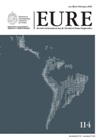Residential segregation in urban Mexico: levels and patterns
DOI:
https://doi.org/10.4067/S0250-71612012000200005Keywords:
urban structure, urban geography, segregationAbstract
Changing patterns of urban development in Latin America have drawn increasing attention to residential segregation, yet there are no systematic quantitative analyses in the literature. Using data from the Mexican census of 2000, this paper measures spatial patterns and levels of segregation by ethnicity and socioeconomic status in over one hundred cities. Findings confirm that many recognized patterns hold across a wide variety of cities. Low-income and informally employed households tend to live in peripheral areas of the city, while high-income households are more centrally concentrated. High-income areas are denser and more socioeconomically diverse. Further, the paper shows that there is a statistically significant relationship between segregation by income and city size; larger cities are more segregated. Similarly, regional differences in patterns of segregation are also statistically significant and large, demonstrating the importance of both historical periods of urbanization and levels of regional economic development.
ÍDownloads
Published
How to Cite
Issue
Section
License
Copyright (c) 2012 Revista EURE - Revista de Estudios Urbano Regionales

This work is licensed under a Creative Commons Attribution 4.0 International License.
Al momento de aceptar la publicación de sus artículos, los autores deberán formalizar la cesión de derechos de autor a EURE, según las condiciones establecidas por la Revista.
Ésta establece que el autor autoriza a EURE de manera gratuita, exclusiva e ilimitada a reproducir, editar, publicar, distribuir, publicitar, comercializar y traducir el artículo, a cualquier soporte conocido o por conocer y desarrollar.
Del mismo modo, los autores aseguran que el artículo propuesto es original, no publicado y no propuesto para tal fin a otro medio de difusión.


